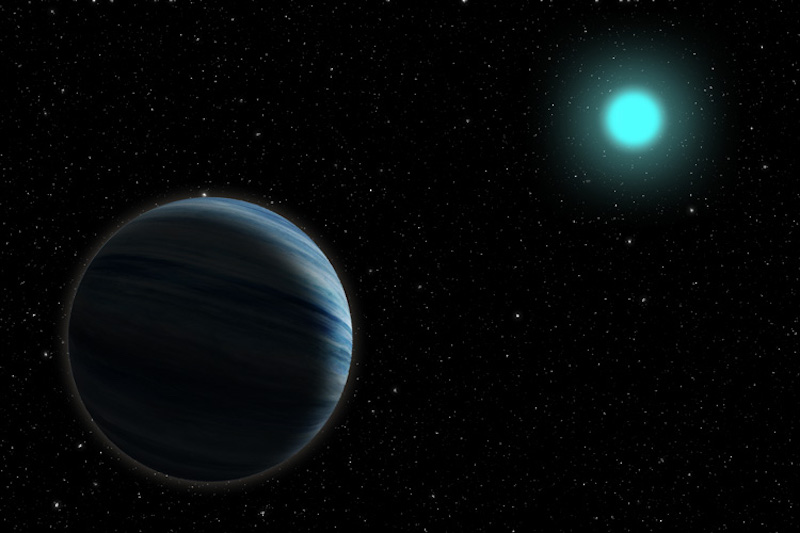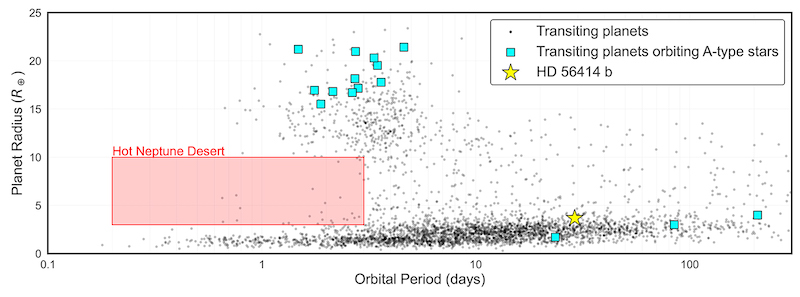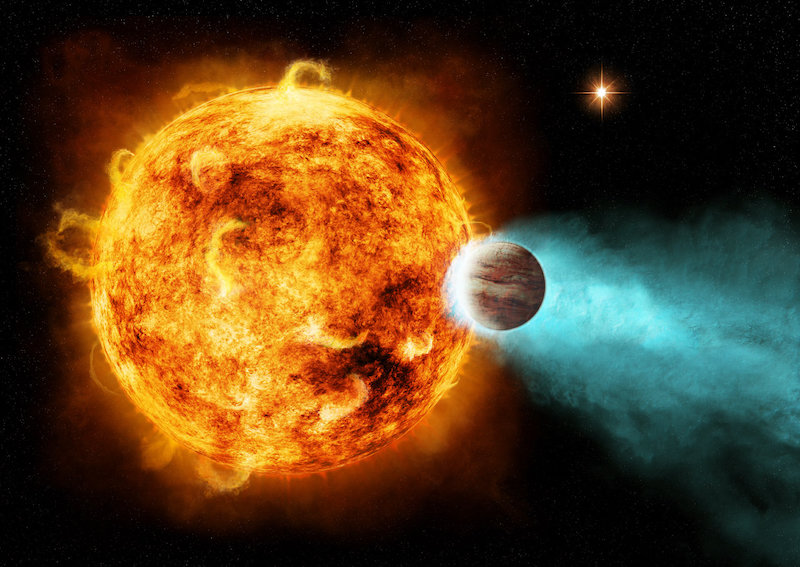
So far, exoplanet-hunting astronomers have found more than 5,000 new worlds orbiting stars in our Milky Way galaxy. Most orbit smaller stars, from red dwarfs (the most common stars in our galaxy) to stars a bit larger than our sun. Where are all the Neptune-sized planets orbiting larger and hotter stars? This month (August 12, 2022), researchers at the University of California, Berkeley, said they’ve discovered a rare Neptune-sized planet orbiting a giant A-type star.
This new discovery lies 873 light-years away in the constellation of Volans the Flying Fish. A-type stars are white or bluish-white and range from about 1.4 to 2.1 solar masses. They are also hotter than our own sun.
The researchers published their peer-reviewed paper on August 12, 2022, in The Astrophysical Journal Letters. Graduate student Steven Giacalone at UC Berkeley is the lead author.
Neptune-sized planet orbiting giant star
The newly discovered planet – HD 56414 b – is about the same size as Neptune. It orbits a giant A-type white star called HD 56414. Astronomers have found very few planets so far around such stars. These kinds of stars are the brightest one percent of stars in our galaxy.
Typically, planets closer to their stars are easier to detect. HD 56414 b, however, is on a longer orbit farther away from its star. The discovery provides clues as to why large planets, similar to Neptune or Uranus in size, are harder for astronomers to find around giant stars.
NASA’s TESS space telescope first detected HD 56414 b. TESS, now retired, used the transit method to find planets. In this method, a planet passes in front of its star as seen from our vantage point on Earth.
The hot Neptune desert
Astronomers already know about the so-called hot Neptune desert. This is a lack of Neptune-sized worlds orbiting close to smaller, usually red stars. Scientists say that radiation from these highly active stars can strip planets of their atmospheres, leaving just a rocky core. Thus, still-intact planets similar to Neptune tend to be rare.
But astronomers don’t know yet whether the same thing happens around A-type stars. That is simply because, so far, astronomers have found very few planets around them to study. HD 56414 b, therefore, is a unique opportunity to do just that. As Giacalone stated:
It’s one of the smallest planets that we know of around these really massive stars. In fact, this is the hottest star we know of with a planet smaller than Jupiter. This planet’s interesting first and foremost because these types of planets are really hard to find, and we’re probably not going to find many like them in the foreseeable future.

Abundant Neptunian cores?
The discovery also suggests that there may be many more formerly Neptune-sized worlds around giant stars that don’t still have their atmospheres. In other words, Neptunian planets stripped of their thick atmospheres, leaving only their rocky cores behind. As the paper noted:
We might expect to see a pileup of remnant Neptunian cores at short orbital periods.
Another study from last year also showed how mini-Neptune planets can shrink by losing their atmospheres. Either radiation from the host star or leftover heat from the planet’s formation can cause this. Again, only the rocky core is left, turning the mini-Neptunes into super-Earths.

Evolution of planetary atmospheres
The findings also provide new clues about how planetary atmospheres evolve. Astronomer Courtney Dressing at UC Berkeley said:
There’s a big question about just how do planets retain their atmospheres over time. When we’re looking at smaller planets, are we looking at the atmosphere that it was formed with when it originally formed from an accretion disk? Are we looking at an atmosphere that was outgassed from the planet over time? If we’re able to look at planets receiving different amounts of light from their star, especially different wavelengths of light, which is what the A stars allow us to do – it allows us to change the ratio of X-ray to ultraviolet light – then we can try to see how exactly a planet keeps its atmosphere over time.
Determining whether the hot Neptune desert also extends to A-type stars provides insight into the importance of near-ultraviolet radiation in governing atmospheric escape. This result is important for understanding the physics of atmospheric mass loss and investigating the formation and evolution of small planets.

This Neptune-sized planet is very young
HD 56414 b and its star are very young, cosmically speaking. They are only about 420 million years old, much younger than our solar system at 4.5 billion years in age. The planet is approximately 3.7 times Earth’s radius and orbits its star once every 29 days. It orbits the star at 1/4 the distance that Earth is from the sun.
So, how long will the planet survive? The researchers estimate about a billion years. After that, the star will burn out and become a supernova. This means that the planet still has most of its atmosphere, even though it is probably being eroded away gradually over time. The longevity, so far, is due to the planet’s large mass. Giacalone said:
There’s this balance between the central mass of the planet and how puffy the atmosphere is. For planets the size of Jupiter or larger, the planet is massive enough to gravitationally hold on to its puffy atmosphere. As you move down to planets the size of Neptune, the atmosphere is still puffy, but the planet is not as massive, so they can lose their atmospheres more easily.
The search continues
Both Giacalone and Dressing want to search for more Neptunian worlds around giant A-type stars. In particular, they want to know where these planets reside in the accretion disk surrounding young stars, whether they move inward or outward and what their atmospheres are like. This will help astronomers better know how common – or rare – they are and how they often end up losing their atmospheres.
Bottom line: Astronomers at UC Berkeley say they have found a rare Neptune-sized planet orbiting a giant, hot star. The discovery provides clues about why these worlds often lose their atmospheres, leaving only their rocky cores behind.
Source: HD 56414 b: A Warm Neptune Transiting an A-type Star
The post A rare Neptune-sized planet orbiting a giant star first appeared on EarthSky.
0 Commentaires